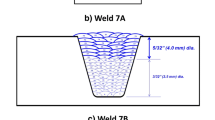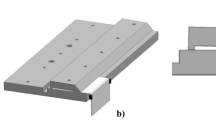Abstract
This paper presents an arc melting technique that allows simulating dissimilar weld metal of high manganese steels with ferritic and martensitic steel grades. The objective of this initial study was to conceive a melting technique that produces dissimilar metal welds using a GTA process in a water-cooled copper crucible under welding adequate cooling conditions and with homogeneous mixing. For this purpose, the sample size, the shape of the crucible, and the melting parameters have been optimized. Using the developed arc melting technique avoids the time-consuming and expensive process of iteratively producing actual welds. It is demonstrated that the dissimilar weld metal microstructure and properties can be easily evaluated for a wide range of dilutions. For an industrially relevant material combination of an austenitic high manganese steel and a ferritic low-alloy steel, the effect of dilution on the weld metal microstructure, the hardness, and the measured ferrite number are shown utilizing the developed arc melting technique. Determining the effect of dilution for a wide range material combination is the basis for the development of a constitutional diagram and will be part of a subsequent paper.









Similar content being viewed by others
References
Grässel O (2003) Development and characterization of new TRIP, TWIP lightweight steels based on Fe-Mn-Al-Si. Dissertation, TU Clausthal-Zellerfeld, (in German)
Kim, S. K.; Cho, J. W.; Kwak, W. J.; Kim, G.; Kwon, O. (2007) Development of TWIP steel for automotive application. 3rd International Steel Conference on New Developments in Metallurgical Process Technologies, Düsseldorf
Keil D (2013) Contribution to welding of high-manganese steels. Dissertation, Magdeburg, (in German)
Mújica Roncery L, Weber S, Theisen W (2012) Welding of twinning-induced plasticity steels. Scr Mater 66(12):997–1001
Kotecki DJ (2000) A martensite boundary on the WRC-1992 diagram—Part 2: the effect of manganese. Welding Journal, Welding Research Supplement, December, pp. 346–354
Kotecki DJ (1999) A martensite boundary on the WRC-1992 diagram. Welding Journal, Welding Research Supplement, May, pp. 180–192
Balmforth MC, Lippold JC (1998) A preliminary ferritic-martensitic stainless steel constitution diagram. Weld J Weld Res Suppl 1:1–7
Balmforth MC, Lippold JC (2000) A new ferritic-martensitic stainless steel constitution diagram. Weld J Weld Res Suppl 12:339–345
Gould EK (2010) Development of constitution diagram for dissimilar metal welds in nickel alloys and carbon and low-alloy steels. Master Thesis, Columbus
Tordonato DS, Madeni JC, Babu SS, Liu S, Mendez P (2010) A new method for the design of welding consumables. Weld J Weld Res Suppl 10:201–209
Schumann H (1966) Double martensite formation in 13% Mn steel. Neue Hütte 11(3):147–152 (in German)
Schumann H (1972) Martensitic transformations in austenitic manganese carbon steels. Neue Hütte 17(10):605–609 (in German)
Schumann H (1977) Austenite transformation in steels. Neue Hütte 22(6):296–301 (in German)
Schumann H (1974) Influence of the stacking fault energy on the crystallographic grating mechanism of the γ/α transformation in high-alloyed steels. Krist Tech 9(10):1141–1152 (in German)
Berns H, Theisen W (2008) Iron materials—steel and cast iron. Berlin, Heidelberg, (in German)
DIN EN ISO 8249 (2000) Welding—determination of ferrite number (FN) in austenitic and duplex ferritic-austenitic Cr-Ni stainless steel weld metals
ISO 9024 (1988) Maunel Point Counting Method for statistically estimating the volume fraction of a constituent with a point grid
Plöckinger E, Straube H (1965) Stainless steel production—melting, casting, testing. Wien, (in German)
Šalak A, Selecká M (2012) Manganese in powder metallurgy steels. Cambridge, Berlin
Schulze G (2010) The metallurgy of welding. Ferrous metals–non-ferrous metals. Berlin, Heidelberg, (in German)
Dilthey U (2006) Welding techniques—behavior of materials during welding. Berlin, Heidelberg, (in German)
Hanus, F (undated) Hardness in the HAZ—effect of the chemical composition of the steel, the welding conditions and the stress relief heat treatment. Dillinger Hütte, (in German)
Acknowledgments
The IGF Project 18660 BR of the Research Community Forschungsvereinigung Stahlanwendung e.V. FOSTA, Sohnstraße 65, 40237 Düsseldorf was supported by the AiF within the programme for promoting the Industrial Collective Research (IGF) of the Federal Ministry for Economic Affairs and Energy (BMWi), based on a decision by the German Bundestag.
Author information
Authors and Affiliations
Corresponding author
Additional information
Recommended for publication by Commission II - Arc Welding and Filler Metals
Rights and permissions
About this article
Cite this article
Wittig, B..., Zinke, M., Jüttner, S. et al. Experimental simulation of dissimilar weld metal of high manganese steels by arc melting technique. Weld World 61, 249–256 (2017). https://doi.org/10.1007/s40194-017-0427-z
Received:
Accepted:
Published:
Issue Date:
DOI: https://doi.org/10.1007/s40194-017-0427-z




